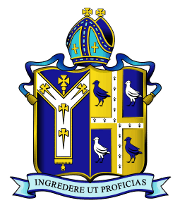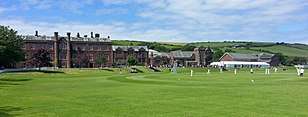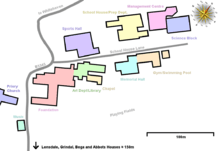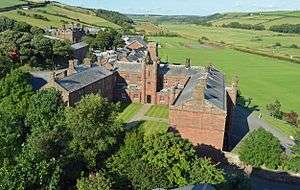St Bees School
St Bees School is a co-educational independent school in the West Cumbrian village of St Bees, England. It was founded in 1583 by Edmund Grindal, the then Archbishop of Canterbury, as a boys' free grammar school. In 1978, the school became co-educational.[3]
| St Bees School | |
|---|---|
 | |
| Address | |
Wood Lane , , CA27 0DS England | |
| Coordinates | 54.4944°N 3.5925°W |
| Information | |
| Type | Independent day and boarding |
| Motto | Latin: Ingredere ut proficias (Enter so that you may make progress[1]) |
| Religious affiliation(s) | Church of England |
| Established | 1583 (reformed 2015–2018) |
| Founder | Archbishop Edmund Grindal |
| Department for Education URN | 145292 Tables |
| Headmaster | Gareth Seddon[2] |
| Years offered | 7 – 12 |
| Gender | Mixed |
| Age | 11 to 18[2] |
| Enrollment | 180[2] |
| Houses | Bega Lonsdale School Grindal |
| Publication | The Pacquet |
| Newspaper | Full Circle |
| School fees | £10,880 |
| Former Pupils | Old St. Beghians |
| Website | www |
Academic performance
In 2012, the GCSE pass rate for the school was 99.8% and over 65% of the results gained by St Bees pupils at A Level were in the A*, A, and B grade categories.[4] The school's most recent Ofsted inspection was in 2018, six months after the school reopened with 10 pupils. Following this inspection, Ofsted inspectors rated the school 'good' on their quality scale.[5]
Creative arts
One of the aims of St Bees is to provide an opportunity for pupils to appreciate the arts as well as to experience the benefit of time on stage and behind the scenes.[6] Music is also featured strongly in the curriculum.[7]
Sports
The school expects that pupils participate in sports, outdoor pursuits and elective activities. The sports offered by St Bees are rugby, squash, hockey, tennis, Eton fives, cross country, swimming, golf, football, water sports, and netball.[8] Additionally, the school offers outdoor activities, such as kayaking, bouldering, climbing, fell running, and camping.
Grounds and buildings


The school grounds occupy Approx. 250 acres (100 ha), and the oldest buildings date from the late 16th century. The buildings around the main quadrangle in the Foundation block are grade II listed.[9] This includes the original schoolroom on the lower northern side of the quadrangle. Lonsdale Terrace is another grade II listed building owned by the school, also built in the mid 19th century.[10] Previously, the school had use of the former chancel of the Priory Church (though it did not own the building), which is a grade I listed building, granting additional protection above grade II.[11] The school used this room for orchestra and choir practices.
History
The school's history is characterized by periods of prosperity interspersed with periods of difficulty. Although the school had a difficult start because the Queen initially refused to sign the letters patent establishing the school, it began to grow, partly because of its ownership of the mineral rights to the surrounding land. However, despite selling these rights for the sum of £3.10s per annum, much less than the market value, and taking part in the resulting legal trouble that lasted for the latter half of the 18th century, the school expanded throughout the 19th, building much of the present-day campus. The school had to be rescued by former members in 1938 because of a financial crisis caused by a sudden drop in pupil numbers. In March 2015 the school's governors announced that, because of falling pupil numbers and the high cost of school fees, the school would close temporarily and be refurbished in the summer of that year.[12] In March 2017 the school announced that it would re-open in September 2018 in a partnership with Full Circle Education Group, a South-East Asian education group.[13] Significant investment has been put into refurbishing the historical buildings.
Founding

The school was founded by the then Archbishop of Canterbury, Edmund Grindal. He had been born in the village of St Bees, at the still-standing Cross Hill House.[14][15] Having fallen out of favour with Queen Elizabeth I, and though ill and blind, Grindal refused to resign his position until the Queen signed the letters patent which would create the Free Grammar School at St Bees. The school was founded in 1583, the year of his death. Thanks to having agreed with Queen's College, and his purchase of local tithes, the school prospered both financially and academically.
Early years
Although specifically incorporated for the education of boys from Cumberland and Westmorland, as early as 1604, people from outside Cumbria were being educated at St Bees in the original school room (now one of the school dining rooms) near the Priory Church. The school slowly expanded, despite one Headmaster who made his few pupils work on the land and act as servants. The school had enjoyed some financial security for many years, lessened in 1742 when the school sold Sir James Lowther an 867-year mineral lease for much less than the market value.
Modern growth
Resulting from an 1842 mineral rights issue obtained through the Court of Chancery the school building expanded physically. A quadrangle was built, Grindal House (formerly a hotel) purchased and the headmaster's residence was constructed. At the turn of the twentieth century, the school's chapel, library, swimming baths, and what is now the art department was built. By the outbreak of the First World War the school had reached a peak of three hundred pupils, a figure which would not be seen again for some years.

During the First World War old boys of the school were awarded the Victoria Cross, the highest award for military gallantry in Britain and many of the British Commonwealth countries (see St. Bees V.C. winners for more details. Old boy Alfred Critchley became one of the youngest Brigadier-Generals in the British Empire at the age of twenty-seven for his heroic conduct (he was older than Roland Boys Bradford, V.C. but younger than Bernard Freyberg, V.C.). One hundred and eighty old boys died during the war, and a special memorial was built overlooking the sports fields where so many had previously played.[16]
After the war, the number of students remained high, but, in common with many other schools, the numbers decreased and then went into free-fall during the 1930s. The situation became so critical that the Governors of the School attempted to have the school nationalized. In the end, the old boys put together a rescue package and the school remained independent.[17]

In 1938, during the final stages of recovery from the Great Depression, the school's headmaster of the day, George Mallaby, made an unusual career move by becoming District Commissioner for the special area of West Cumberland, with the task of alleviating the problems of unemployment.[18]
During the Second World War, Mill Hill School was evacuated to St Bees after the latter's buildings in London were occupied by the government. The two schools remained independently run, and sports teams from each school would frequently play each other.[19] The cadet corps of the two schools combined with village volunteers to form the St Bees Home Guard, resulting in the group being much earlier equipped than many other Home Guard groups, as the cadets from both schools already had the necessary equipment.[20]
Post-war expansion
Seventy-two old boys died during the Second World War, and the Memorial Hall was erected in their memory. During the 1950s a new science block was built, formally opened by Barnes Wallis in 1959,[21] and in the 1970s the school became co-educational. New boarding houses were purchased for both girls and boys, Bega House and Abbot's Court respectively, and to celebrate the school's quatercentenary in 1983 an appeal was launched which would give the school a new sports hall, opened in 1988. The 1990s saw the opening by Prince Charles of the Whitelaw Building, a multi-function business centre and teaching area which was named after the then chairman of the board of Governors, William Whitelaw. In 2000, Barony House was entirely refurbished and renamed the Fox Music Center in memory of old St Behgian Bill Fox. To mark the millennium, a time capsule was buried in the north-east corner of the Quadrangle. In September 2008, a Preparatory Department was launched, catering for pupils from the age of 8 until they joined the main school. At this time, a nearby independent school with a prep department, Harecroft Hall, had just closed.[22] The school again expanded in September 2010 to include pupils from age four.
Temporary refurbishment
On Friday 13 March 2015 it was announced by the School Governors that due to falling pupil numbers and the cost of their school fees, the school would temporarily close in Summer 2015. In response a four-point rescue plan was proposed on 23 March by a "rescue team" made up of interested stakeholders.[23]
The plan was to:
- Work on a legal mechanism to take control from the current board of governors
- Rescind the current closure notice and replace with a preliminary closure notice to the Summer Term of 2016.
- Use the next nine months to raise funds and to develop a supported and sustainable business plan for the school
- Throughout this period post frequent updates on progress on the website and issue a substantive interim report of progress before the end of the Summer Term. Then by Christmas term 2015 formally confirm or withdraw the preliminary closure notice based on the success of the rescue business plan.[24]
Closure and reopening
On the 17 April 2015, it was confirmed by the governors that the school would close. A formal statement said the governors were also trustees of the St Bees Foundation, and that they are committed to it having a future in education in west Cumbria and "to the use of the site as support both for the future activities of the foundation and the village of St Bees."[25]
The school re-opened in 2018.[2][26]
However, on the 20 March 2017 it was announced that the school would re-open in September 2018 in a partnership with Full Circle Education Group after the refurbishment.[27] On 5 May 2017 the Trustees announced that the Headteacher Designate would be Jeremy Hallows, who was then Head of the Senior School at Bromsgrove School.[28] In April 2018 it was announced that the school would open initially with a cohort of Year 7 students. After a leadership change and the departure of Jeremy Hallows, Gareth Seddon was appointed as Headmaster. The School opened on 6 September 2018.[29]
Old St. Beghians
Former pupils of St. Bees School are styled 'Old St. Beghians.' An Old St. Beghians' Club was founded in 1908 by master J.W. Aldous. Today, it is known as the 'Old St. Beghians' Society' and provides a link between old boys (and girls) and the school. Among other things, it organizes "Old St Beghians Day" once a year, publishes a magazine called the Old St. Beghian twice a year, and both holds and participates in many golfing tournaments. There are several regional branches of the society which traditionally hold annual meals and reunions.[32]
Notable Old St. Beghains include two Vice-Chancellors of the University of Cambridge, a number of professors, and three Victoria Cross recipients. The comedian and actor Rowan Atkinson also attended the school as a pupil.[33]
See also
- List of headmasters of St. Bees School
- List of Old St. Beghians
- List of the oldest schools in the United Kingdom
- List of the oldest schools in the world
- List of Victoria Crosses by School
- Listed buildings in St Bees
Citations
- "St. Bees Village Website – School History". Archived from the original on 4 April 2012. Retrieved 15 April 2012.
- "St. Bees School". Get information about schools. DfE. Retrieved 27 April 2020.
- "Independent Schools Inspectorate – St Bees Report" (PDF). Retrieved 29 May 2011.
- "Boarding School Association". Archived from the original on 2 August 2018. Retrieved 2 August 2018.
- "St. Bees School". Ofsted. Ofsted. Retrieved 27 April 2020.
- "St Bees School Creative Arts". Archived from the original on 2 August 2018. Retrieved 2 August 2018.
- "St Bees School Curriculum". Archived from the original on 1 August 2018. Retrieved 1 August 2018.
- "St Bees School Sports". Archived from the original on 2 August 2018. Retrieved 6 August 2018.
- "British Listed Buildings – St Bees School Buildings". Archived from the original on 28 September 2012. Retrieved 2 June 2011.
- "British Listed Buildings – 1–11, St. Bees". Retrieved 2 June 2011.
- "British Listed Buildings – Music Room in former Chancel to Priory". Archived from the original on 2 September 2012. Retrieved 2 June 2011.
- Whitehaven news web site 13 March 2015 Archived 22 July 2015 at the Wayback Machine
- Press release from St Bees School trustees. Retrieved 20 March 2017
- "Archbishop Grindal's Birthplace: Cross Hill, St. Bees Cumbria", By John and Mary Todd. Transactions of the Cumberland and Westmorland Antiquarian and Archaeological Society 1999, Vol XCIX.
- "Veterans look to the future". News and Star. 13 January 2006.
- Aldous, M.A., J.W. (1921). St. Bees School Roll of Honour and Record of Service. Edinburgh: University Press.
- "Future of St.Bees School". The Glasgow Herald. 7 July 1938. Retrieved 31 May 2011.
- Gittings, Robert, 'Mallaby, Sir (Howard) George Charles (1902–1978), public servant and headmaster' in Oxford Dictionary of National Biography, online version (subscription required). Retrieved 10 August 2008
- "Poignant last reunion". The Whitehaven News. 23 April 2009. Archived from the original on 21 June 2013. Retrieved 17 April 2012.
- "Mill Hill School at St Bees". Archived from the original on 12 March 2012. Retrieved 17 April 2012.
- "{title}". Archived from the original on 12 January 2015. Retrieved 11 January 2015.
- "18 jobs lost as school to shut". The Whitehaven News. 23 April 2008. Archived from the original on 2 September 2011. Retrieved 2 June 2011.
- "Rescue St Bees School" website – retrieved 23 March
- ""Rescue St Bees School" website – retrieved 23rd March". Archived from the original on 25 March 2015. Retrieved 27 March 2015.
- West Cumberland News and star Archived 22 July 2015 at the Wayback Machine
- "St. Bees School". Get information about schools. DfE. Retrieved 27 April 2020.
- "{title}". Archived from the original on 2 August 2018. Retrieved 2 August 2018.
- Press release 5 May 2017 by the Trustees of St Bees School
- "{title}". Archived from the original on 1 May 2018. Retrieved 1 May 2018.
- "St Bees School UK Fee Schedule 2018–19". Archived from the original on 2 August 2018. Retrieved 2 August 2018.
- "St Bees School Scholarships And Bursaries". Archived from the original on 2 August 2018. Retrieved 2 August 2018.
- "About the Society (OSB)". Archived from the original on 17 August 2013. Retrieved 17 April 2012.
- "Chortle Profile – Rowan Atkinson". Archived from the original on 17 August 2011. Retrieved 29 May 2011.
Reference list
- Aldous, J. W. (1921). St. Bees School Roll of Honour and Record of Service. Edinburgh: University Press.
- Special Committee, Old St. Beghians' Club (1939). The Story of St. Bees 1583–1939: a souvenir of the 350th anniversary of the opening of St. Bees School. London: Buck & Wooton. OCLC 223279332.
- Strype, John (1974) [1710]. The history of the life and acts of the Most Reverend Father in God, Edmund Grindal: the first Bishop of London, and the Second Archbishop of York and Canterbury successively, in the reign of Queen Elizabeth, to which is added an appendix of original mss.; in two books. New York: Burt Franklin research & source works series. OCLC 313493627.